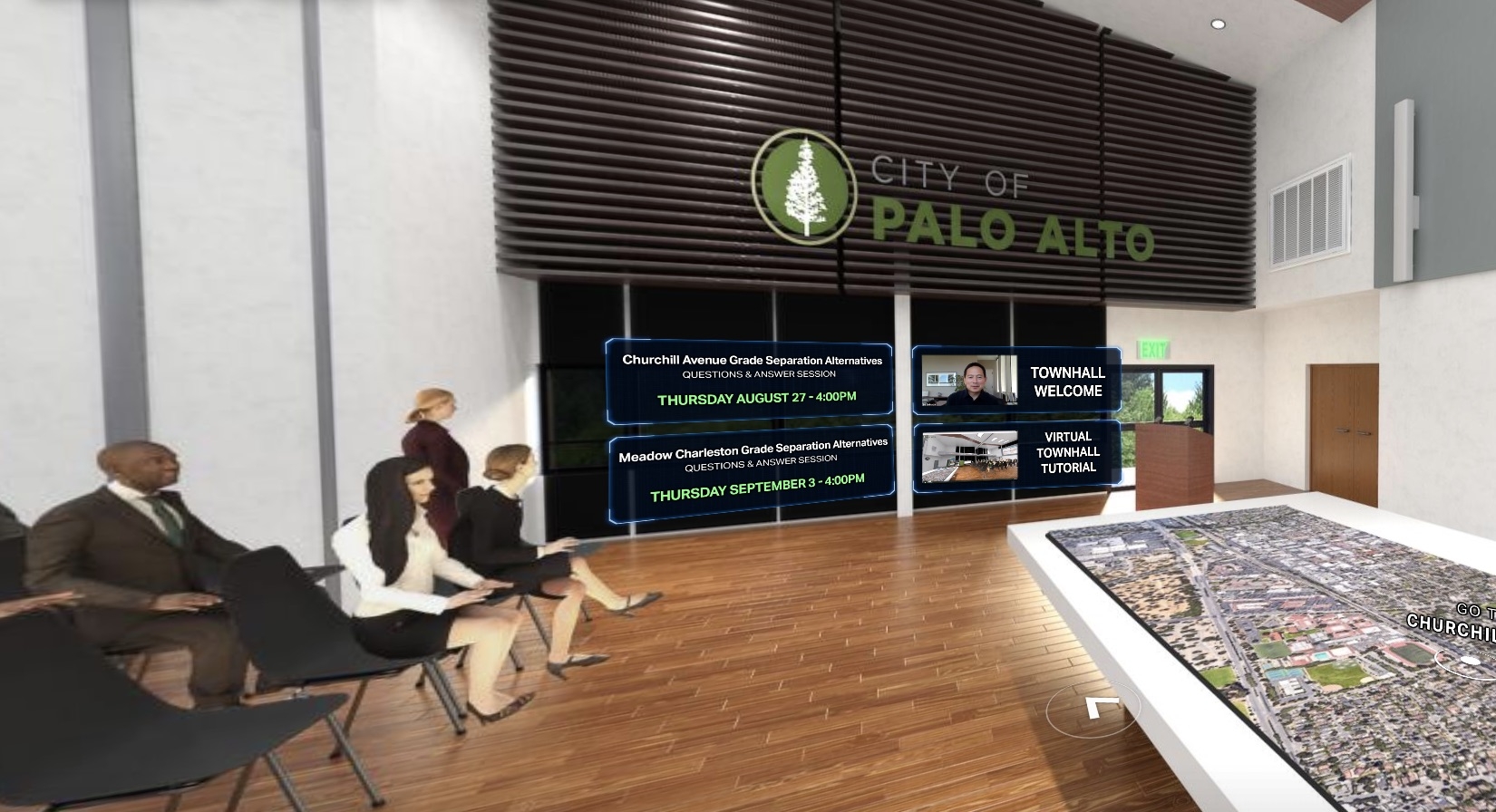With Palo Alto approaching a key decision in its multiyear effort to redesign four rail crossings, residents can now attend community meetings on the complex project without leaving their homes.
The city recently unveiled a Virtual Town Hall that allows residents to enter a digital version of Mitchell Park Community Center, the site of prior town hall on the rail project, and view presentations, videos and fact sheets about each of the nine options currently on the table for grade separation (the physical separation of the railroad tracks from streets at rail crossings).
The setup in the virtual room is modeled after the real community meetings that the city has been holding over the past three years, with characters resembling The Sims video games series filling the space to watch a presentation on the projection screen at the end of the room. Participants can toggle between the eight design options (no information is available on the ninth option for Churchill Avenue), watch narrated video simulations of the alternatives and provide feedback about the alternatives to the city.
The virtual town hall began on Aug. 19 and will remain in place until Sept. 7. The city also plans to hold two live, Virtual Town Hall Q&A sessions on its YouTube channel. The first will be on Aug. 27 at 4 p.m., which will focus on the Churchill Avenue alternatives. The second is set for on Sept. 3 at 4 p.m. to focus on the Meadow Drive and Charleston Road alternatives.
The virtual room is designed to "bring community members up to date and enabled to weigh in on our rail planning effort," City Manager Ed Shikada said in a video presentation at the Virtual Town Hall.
"You will literally be able to walk through, at a pace and time of your convenience, to take a look around, get information, come back again if you'd like to, on demand, when it is convenient for you," Shikada said.
The grade separation project, which has been in the works for several years and which is by far the largest infrastructure effort that Palo Alto has undertaken in generations, is entering a key phase in the coming months, with the City Council scheduled to choose its preferred alternatives this fall or winter. The COVID-19 pandemic has slowed down the planning effort and has forced the stakeholder group, Expanded Community Advisory Panel (also known as XCAP), to cancel numerous meetings before holding virtual gatherings.
The panel is scheduled to discuss Churchill Avenue alternatives at its Aug. 26 meeting. The three Churchill Avenue alternatives currently on the table are the closure of Churchill to traffic (combined with various traffic mitigations on Embarcadero Road and other roadways that would see impacts from the closure); a viaduct; and an underpass.
The city is also considering four options for the Meadow and Charleston alternatives: a trench, a viaduct, an underpass and a "hybrid" that combines raising the tracks and lowering the roads. The city is also considering two different options for south Palo Alto tunnels, one of which would keep freight trains at grade.
Visit the Virtual Town Hall at vrpaloalto.com.



Comments
Registered user
Palo Alto Orchards
on Aug 24, 2020 at 11:03 am
Registered user
on Aug 24, 2020 at 11:03 am
Doing nothing --- leaving Churchill Avenue just the way it is -- is a very viable alternative, yet it is not presented as one in the City's Virtual Reality Town Hall presentation.
While Caltrain will recover eventually, from losing 95% of its ridership, to approach its prior (65k daily) ridership levels, it will take a long time to even do that. It's prior (very optimistic) projections to triple its ridership are rightfully out the window. Given public health and safety concerns about public transportation use (Covid 19 transmission), along with changing work patterns, like permanent and part time remote work, and workers who no longer even need to live in Silicon Valley, the need for increased Caltrain train frequency (and the $22 billion cost) is not there. Increased Caltrain service frequency is what prompted the discussions of the costly grade separations in the first place.